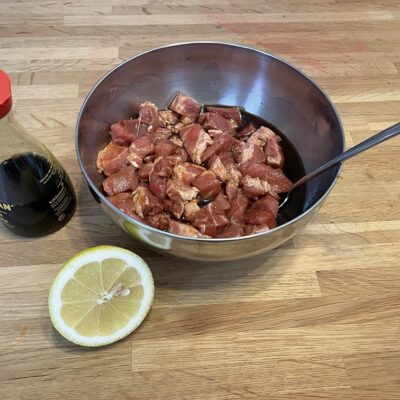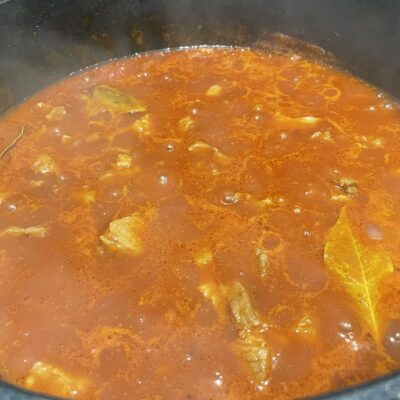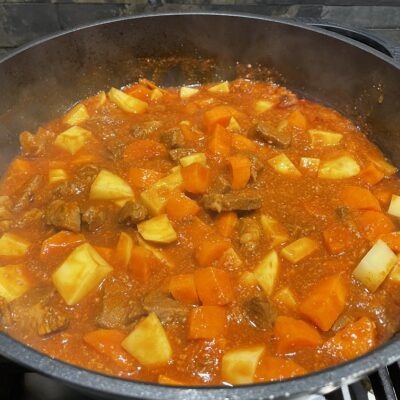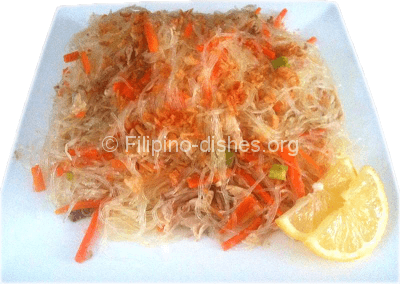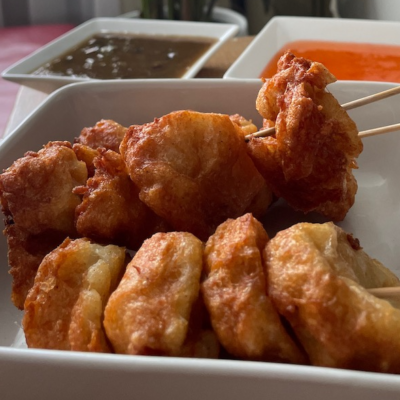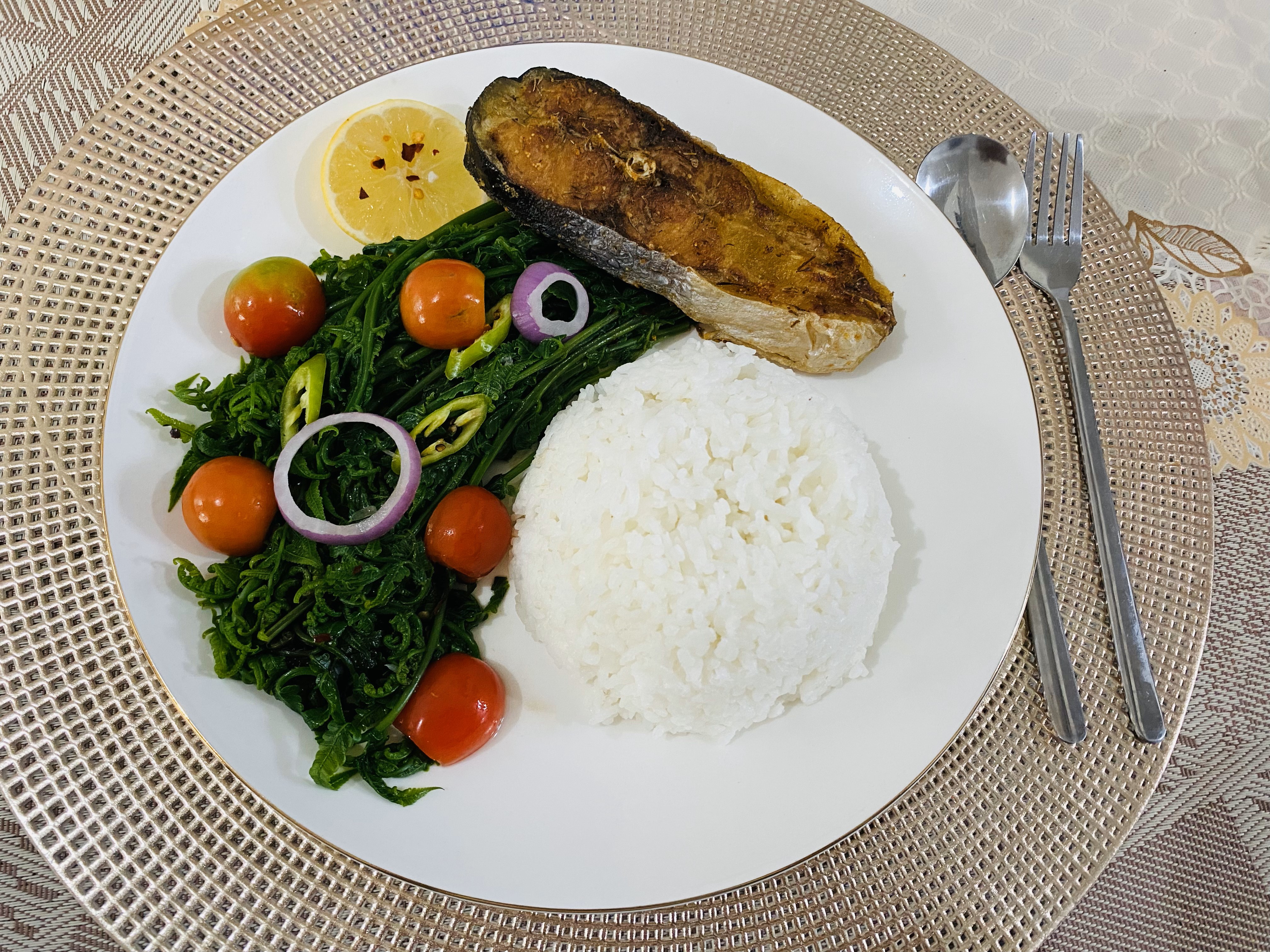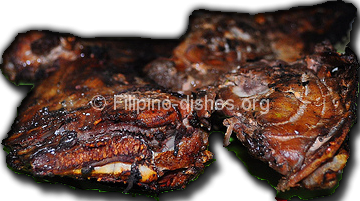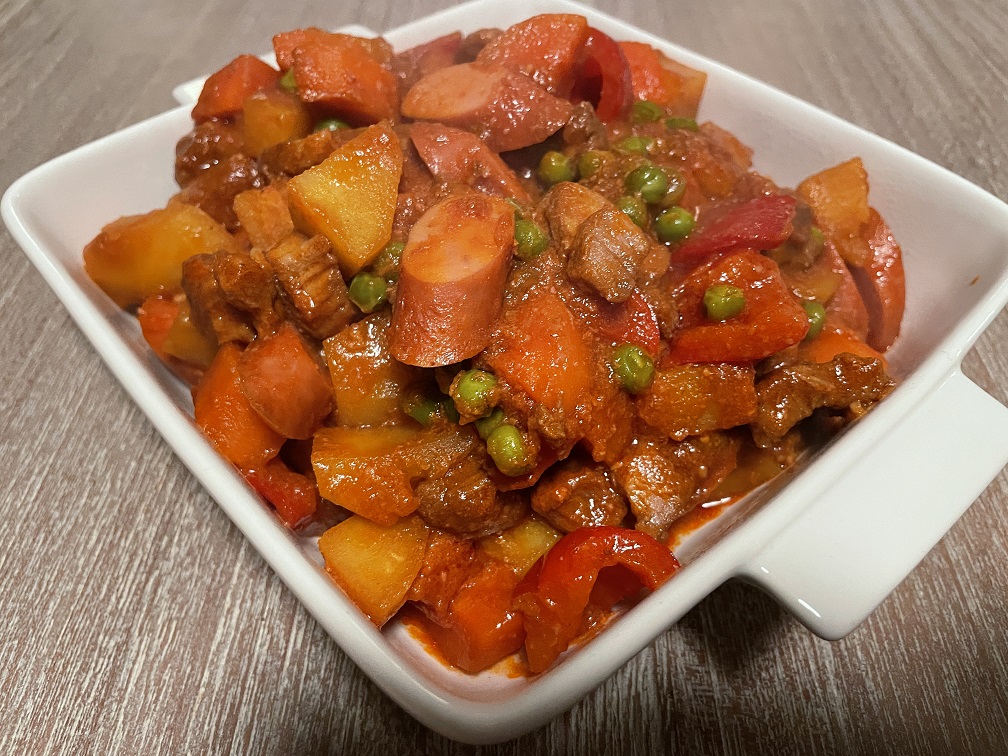

Pork Menudo Recipe
Menudo recipe is a classic favorite of many Filipinos. Pork menudo Recipe has always been a peasant food and comes in many various versions
Ingredients
-
500 grams Porkcubed
-
0,5 Lemonsqueezed
-
150 ml Soy Sauce
-
0,5 liter Water
-
4 tbsp Cooking Oil
-
4 Cloves Garlicminced
-
2 Medium sized PotatoesCubed
-
2 Medium sized CarrotCubed
-
To taste Salt
-
To taste Black Pepper
-
1 Piece Red OnionChopped
-
1 Piece Red Bell PepperCubed
-
125 grams Peas(1 cup)
-
3 Pieces Bay Leaves
-
1 tbsp Sugar
-
2 cans Pork Liver112 grams
-
250 ml Tomato Sauce
-
5 pieces Hot DogSliced Diagonal
Directions
Menudo: History and Recipe in Filipino Culture
I have come to know that most Filipinos fancy eating meat and pork dishes and in some local provinces, in the olden days, it is actually considered a status symbol as only rich families can afford to make it part of their regular menu. Other families get to experience the luscious, savory meat dishes during town fiestas when rich relatives open their doors to extended family members and neighbors who come to partake in the food served on their banquet. And that was believed to please the patron saint of whose fiesta they are celebrating. And if the patron saint is pleased, they believed that they and their household will receive further blessings and greater favor for the entire year. A decadent religious Spanish influence right there!
True enough, I found one of the pork dishes that is a classic favorite of many Filipinos young and old alike, is the pork menudo. The term menudo, according to Merriam-Webster dictionary is a tripe stew seasoned with chili peppers. I was expecting for it to have a flamboyant, hot, chili flavor as a common trait of most Asian foods, but I was surprised that menudo is actually of Mexican origin. And of course, since Mexico is also one of the colonized countries of Spain, then that gives menudo its Spanish origin. What did I expect?
The original menudo dish was supposedly created from cooking left-over cow parts (mostly the tripe) and tomatoes commonly grown in backyards in Mexican households. Although there is no solid documentation about it, the beef tripe was supposedly cut into small bits marinated in salt and water for a few hours, and then boiled until tender. An onslaught of herbs and spices and a large quantity of sliced, ripe tomatoes are then added and cooked until the red, pasty sauce is rendered. That was the simplest version of cooking menudo by far that was featured in most blogs I have come across. And I was surprised at how menudo, its ingredients, and manner of preparation, had evolved into a flavorful treat that we come to know and loved at the present.
For instance, according to Esquire Philippines, there was *a Mexican cookbook published in 1844, the La cocinera de todo el mundo, o la cocina sin cocinera: coleccion de las mejores y mas escelentes recetas, where a recipe can be found for menudo à la española. This particular menudo version points to Spain’s Andalusian region as the birth town of the menudo recipe and was actually called callos de Cadiz. Many culinary communities in Mexico acknowledge the resemblance as was documented in the cookbook. The recipe had featured the use of starchy kernels like chickpeas or garbanzos to achieve a certain level of viscosity in the sauce. And I think that version had become widely known and used in most households. Although there are some that also use breadcrumbs to thicken the sauce for an even fanciful treat.
The fact is, menudo is so traditional and so popular not only in Mexican and Latin countries, that every country may have had its own version and style of cooking, and of course, they may also have a legit reason for preparing this intriguing dish. One of the popular beliefs is that the beef tripe used in menudo may potentially cure a person’s hangover. The beef tripe, which is actually the cow’s stomach lining cut into bite-size pieces, is believed to help absorb the alcohol from last night’s drinking session and would cure the person who has eaten it of the bad effects of a hangover. You may remember that Tapsilog has the same benefits. That could probably be the reason why most Mexican restaurants have the menudo stew or soup as one of their main attraction. Either that or they just simply dig the aromatic and flavorful ensemble of hot, meaty concoction eaten with a plate or two of steaming white rice or bolillo, which is a Mexican version of the crusty French bread.
Menudo has two well-known versions, the menudo rojo, and the menudo blanco. The menudo rojo (red menudo), which is common in northern parts of Mexico, has dried chiles as one of its main ingredients, giving it a trademark red color and that distinct, extra punch when eaten hot off the pot. The menudo blanco, on the other hand, is basically the same except without the dried chiles. Some use jalapeno or chopped green pepper to give it just a little bit of spice. This version is more prominently used in Sinaloa and central Mexico. Both versions use tripe for the meat and portions of hominy, cilantro, oregano, ground pepper, red bell pepper, lemon, onions, and garlic. Just looking at the ingredients, one will know that they are surely in for a spicy treat.
In Filipino cooking, menudo is oftentimes cooked using pork and liver as meat. That is because not everyone in the family would favor the use of beef tripe in their meal. So most of the time the tripe is served to the husbands and/or other members of the family that takes a fancy to this particular type of menudo dish. The other ingredients used are consist of vegetables namely carrots, potatoes, green peas, red bell pepper, and sun-dried raisins. Onions, garlic, and bay leaves add to the inviting aroma that helps create this favorite recipe. And for the base, they use a generous amount of tomato sauce. Yes, they do enjoy lathering their dinner plate in the rich, saucy goodness of tomatoes. For Filipinos, the more tomato sauce there is in a dish, the better. Tomato sauce can either be rendered from crushing fresh tomatoes while sauteing or using the commercial ones sold in tetra packs or bottles, which are sold in almost all local stores in the neighborhood.
And while it is true that the recipe may have already been richly altered in its context from every region, it will always taste great no matter how it is prepared and regardless of the ingredients used. Most Filipino would refer to menudo as their favorite comfort food. They actually mean that they cannot live a week or a month without eating it. And sure enough, their favorite version of cooking would be the menudo cooked by their mamas or aunties or grandmothers. For every adult Filipino, every particular dish would instantly bring them back to childhood memories with their mothers or Lolas (grandmothers) doing their busy rounds in the kitchen, cooking food for the entire family on Sundays or on any special occasions.
I have recently tried cooking the Filipino version of the classic pork menudo and suffice to say that I loved how the cooking had turned out. It actually is a simple recipe as long as you follow the instructions and make sure to read on some helpful tips to make it a pleasant cooking experience for those who are doing it for the first time. From my own experience, the sauce got too thick that I had to continually add in small portions of water from time to time until the pork meat was cooked. Thankfully, the dish came out just as delicious as I imagined it to be.
Nowadays in the Philippines, one can simply go and check in a nearby restaurant or even in small carinderia and the pork menudo will always be on the recipe for the day. Although still the favorite putaje (dish) in any banquet It did not need to be prepared for special occasions only as it used to in the Spanish era of the golden long ago, nor is it to be associated with rich families only. Everyone deserves to have a treat of this colorful and delicious dish regardless of their status in society. And every one of all ages can learn how to cook the menudo and hopefully pass it on, along with its colorful history, to their great-great-grandchildren.
I bet the peasant who had cooked the first menudo dish will be glad to know how his mere act of survival has actually become a heated topic for debate across the world. Some people would find the dish unappealing due to it using a cow’s stomach for food. And we all respect their opinion about the matter. We all have our preferences and sometimes it is difficult but we just need to be respectful of the different cultures that we have around us.
The pork menudo has always been a peasant food and you will all agree that it may have seen various versions or altercations through the course of history, but its real purpose is always to cure our hunger and to also fill our hearts with that special joy, that joy we find when our families are gathered together at the dining table, sharing stories, laughing, and eating together.
And in the hearts of the Filipinos, the menudo will definitely go a long way as an all-time favorite dish of every household. If you have tasted or eaten menudo before, you will understand why.
Add the Pork liver and keep stirring the mixture for about 1 minute.
Recipe Reviews
Ingredients
| 500 grams Pork | |
| 0,5 Lemon | |
| 150 ml Soy Sauce | |
| 0,5 liter Water | |
| 4 tbsp Cooking Oil | |
| 4 Cloves Garlic | |
| 2 Medium sized Potatoes | |
| 2 Medium sized Carrot | |
| To taste Salt | |
| To taste Black Pepper | |
| 1 Piece Red Onion | |
| 1 Piece Red Bell Pepper | |
| 125 grams Peas | |
| 3 Pieces Bay Leaves | |
| 1 tbsp Sugar | |
| 2 cans Pork Liver | |
| 250 ml Tomato Sauce | |
| 5 pieces Hot Dog |


